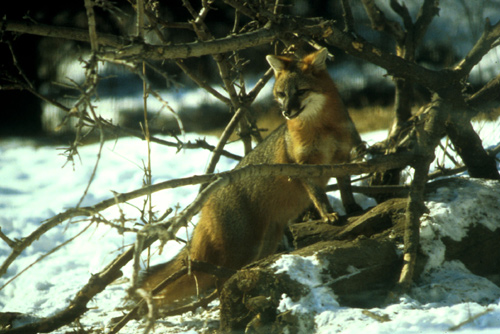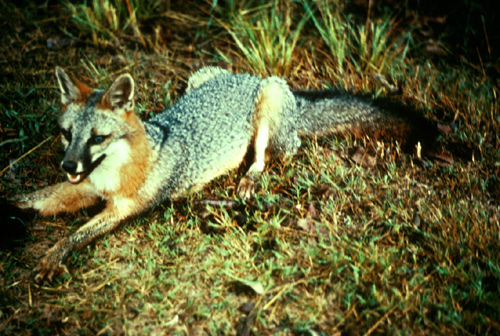Gray fox are widespread in Connecticut. They have a mostly grizzled gray fur coat that is accented by other patches of color. Rusty red fur is on their neck, chest, the back of their ears, and under their tail . Their throat, belly and inside of their ears are white, and there are black markings on their faces. Their 8 1/2 to 17 1/2 inch tails are bushy and gray with black fur along the top as well as at the tip. They have pointy muzzles that are broader and shorter than a red fox's, and a stockier build than their red counterpart.
Gray fox range through most of the eastern US, even pushing into southern Maine over the last several years. They are in some areas of the southwestern states, all of Texas and parts of California. They are active year-round. They are usually most active at dusk and at night. Gray fox prefer wooded or brushy habitat and will live in residential areas with those characteristics. As the amount of farmland in Connecticut has decreased and more woods have returned, the population of gray fox has increased.
Gray fox are omnivores. Their favored prey is the cottontail rabbit and it is belived they have expanded into the New England area by following this prey source. They eat other small animals such as mice, voles, squirrels, birds, frogs, crayfish and insects. They will eat corn, nuts, berries and fruit in the warm months. The scenario of a fox raiding the chicken coop is a classic one. Like coyotes, fox will eat small pets such as cats and small dogs if the opportunity arises. Don't leave small pets outside unattended, especially at night, when gray fox live in your area. Fencing can be used to protect the garden plants they eat. Chicken coops and pens for other small livestock must be well sealed and fenced. Keep in mind that fox can dig under fences or climb over ones that are small enough.
Gray fox mate in January through May, March is the peak month. A litter averaging 4 to 5 pups is born in April or May. A mated fox pair will remain together the breeding season. The father fox helps provide food for the young but he doesn't live in the den with the family.
Grey fox don't usually dig an underground burrow for a den. They most often use a natural crevice, a hollow log, an area in dense brush or spots under man-made outbuildings. Fox prepare several dens for their pups, and if disturbed at one site will move their young to one of the alternative dens. A den might be reused for several years for raising their young each season.
Gray fox are solitary except during the breeding season and while raising their young. Families disperse in the fall. Unless caring for a family, gray fox don't maintain a permanent home.
A typical gray fox territory in Connecticut will be 2 to 4 square miles. The interaction of gray fox and coyote have not been studied, and it is unknown if coyotes are as intolerant of gray Fox in their territory as they are of red Fox. Gray fox also bark and yap but aren't as vocal as red fox.
Neat Fact
Gray fox are one of the few members of the dog family that readily and easily climb trees. They can grip a tree trunk with their front legs and push themselves up with their hind feet, similar in manner to the way humans will climb a palm tree trunk. When they reach a large branch they can climb higher in the tree by jumping from branch to branch. They descend the tree trunk backwards. Trees are climbed to pursue prey, forage for other foods, and to take refuge from danger. Some reports have even been made of gray Fox denning in a tree.

